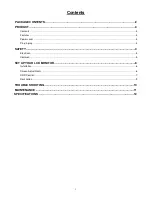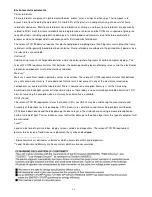
13
Congratulations!
You have just purchased a TCO’99 approved and labeled product! Your choice has
provided you with a product developed for professional use. Your purchase has also
contributed to reducing the burden on the environment and also to the further development
of environmentally adapted electronics products.
Why do we have environmentally labeled computers?
In many countries, environmental labeling has become an established method for encouraging the adaptation of
goods and services to the environment. With the growing manufacture and usage of electronic equipment throughout
the world, there is a recognized concern for the materials and substances used by electronic products with regards
their eventual recycling and disposal. By proper selection of these materials and substances, the impact on the
environment can be minimized.
There are also other characteristics of a computer, such as energy consumption levels, that are important from the
viewpoints of both the work (internal) and natural (external) environments. Electronic equipment in offices is often
running continuously, resulting in unnecessary consumption of large amounts of energy and additional power
generation. From the standpoint of carbon emissions alone, it is vital to save energy.
What does labeling involve?
This product meets the requirements for the TCO’99 scheme which provides for international and environmental
labeling of personal computers. The labeling scheme was developed as a joint effort by the TCO (The Swedish
Confederation of Professional Employees), Svenska Naturskyddsforeningen (The Swedish Society for Nature
Conservation) and Statens Energimyndighet (The Swedish National Energy Administration)
Approval requirements cover a wide range of issues: environment, ergonomics, emission of electric and magnetic
fields, energy consumption and electrical safety.
Environmental criteria impose restrictions on the presence and use of heavy metals, brominated and chlorinated
flame retardants, CFCs (freons) and chlorinated solvents, and other materials. The product must be prepared for
recycling and the manufacturer is obliged to have an environmental policy which must be adhered to in each country
where the company implements its operational policy.
Energy requirements include a demand that the computer and/or display, after a certain period of inactivity, shall
reduce its power consumption to a lower level in one or more stages. The length of time to reactivate the computer
shall be reasonable for the user.
Labeled products must meet strict environmental demands, for example, in respect of the reduction of electric and
magnetic fields as well as physical and visual ergonomics.
Below you will find a brief summary of the environmental requirements met by this product. The complete
environmental criteria document may be ordered from:
TCO Development
SE-114 94 STOCKHOLM, Sweden
Fax: +46 8 782 92 07
E-mail (Internet):
Current information regarding TCO’99 approved and labeled products may also be obtained via the Internet, using
address: http://www.tco-info.com/
Summary of Contents for fa-19w1s-h2a
Page 16: ...15 ...


































